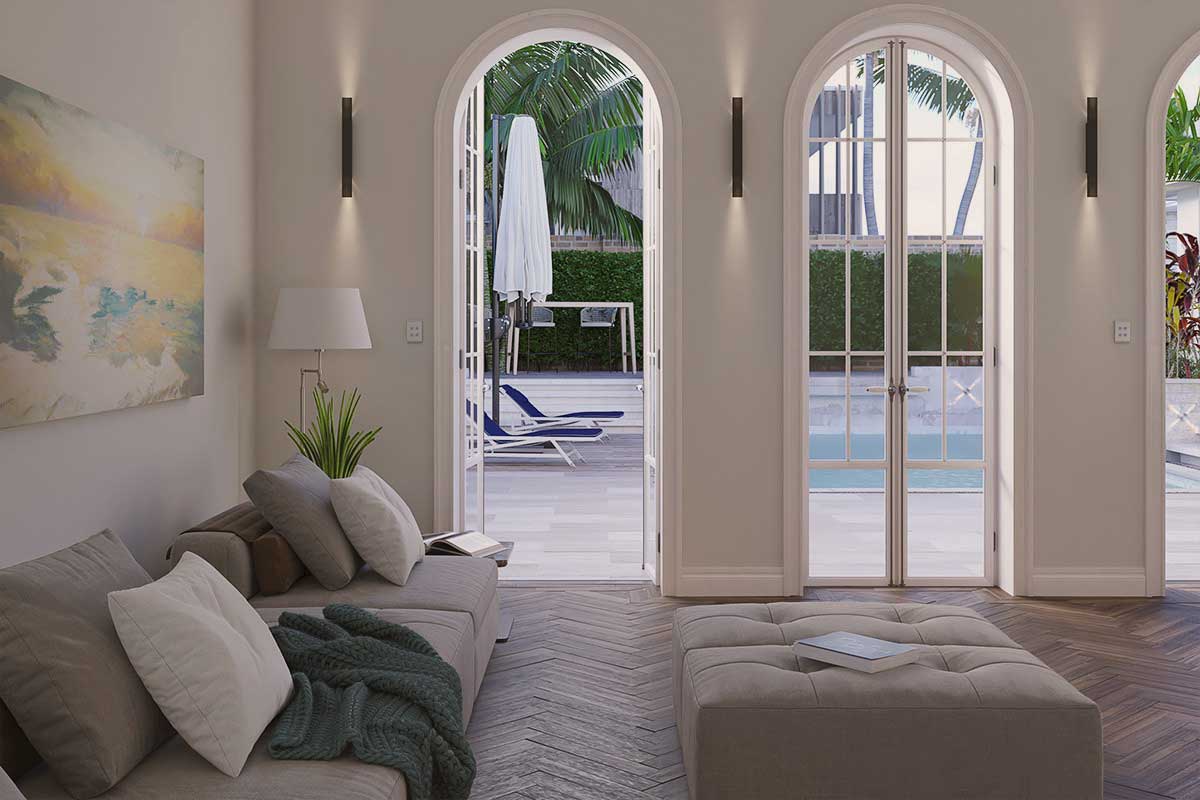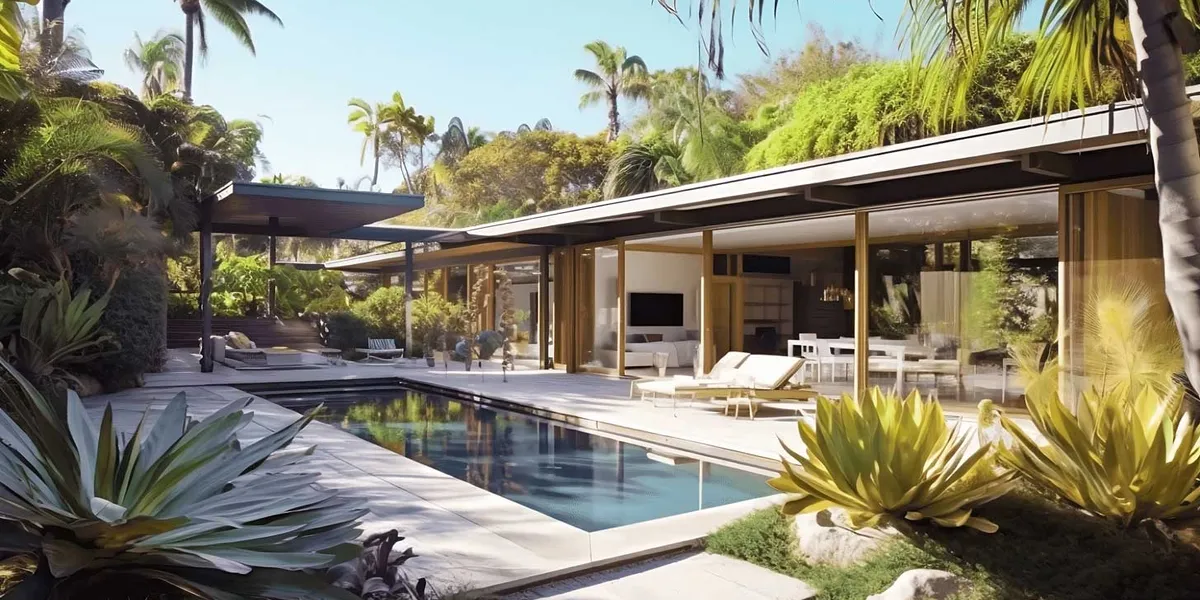When it comes to architectural design, there’s often a debate between creating timeless spaces that withstand the test of time and designing structures that are on-trend and in line with current fashions. As architects, our goal is to strike a balance between these two approaches, with a strong emphasis on timeless design principles that aim to keep our projects remain relevant, functional, and beautiful for years to come.
In this post, we’ll explore the differences between timeless and on-trend architecture, the benefits of prioritising timeless design, and how we incorporate these principles into our work.
So, let’s dive in and uncover the magic behind creating spaces that stand the test of time.
Timeless vs On-Trend Architecture: Understanding the Difference
Timeless Architecture
Timeless architecture is characterised by its ability to remain relevant, appealing, and functional, even as design trends and fashions come and go. At its core, timeless design focuses on simplicity, balance, and harmony, with a strong emphasis on the use of quality materials and expert craftsmanship.
Timeless architecture often draws inspiration from various historical styles and periods, as well as the natural environment, blending these influences to create spaces that are both familiar and innovative.
Let’s outline some key characteristics of timeless architecture in more detail:
-
Simplicity and/or Character: Timeless design often focuses on the essential elements of a space, eliminating unnecessary details or ornamentation to promote functionality and aesthetics.
-
However, in certain architectural styles, like the Queenslander or Hampton’s, characteristic decorative elements contribute to their enduring appeal.
-
In these instances, even if the design isn’t strictly ‘simple’, it maintains a sense of clarity and purpose where ornamentation adds to the character of the structure without compromising its balance or proportion.
-
Balance and Proportion: Balance and proportion are fundamental principles in timeless design that ensure the various elements of a space are visually harmonious and well-coordinated. Balance refers to the even distribution of visual weight, achieved through the arrangement of shapes, colors, and textures.
-
Proportion, on the other hand, deals with the relative size and scale of elements in relation to one another and to the space as a whole.
-
For instance, if a room has high ceilings, taller furniture pieces like bookshelves or a floor-to-ceiling fireplace could be incorporated to visually connect the lower and upper areas of the room.
-
Similarly, artwork and decorative items should be chosen and arranged based on their relative size and scale, ensuring that they neither overwhelm nor get lost in the space.
-
Quality Materials and Craftsmanship: Timeless design emphasizes the importance of using high-quality materials and skilled craftsmanship in the creation of enduring structures. The choice of materials is crucial, as it directly impacts the longevity, performance, and appearance of a space.
-
Timeless design often relies on natural, sustainable materials that age gracefully and require minimal maintenance. Craftsmanship plays a significant role as well, as expert artisans ensure that every detail is executed to the highest standard.
-
Adaptability: Adaptability in timeless design is the ability of a space to evolve and change in response to the needs of its occupants and the surrounding environment. This quality is achieved through the thoughtful consideration of a structure’s layout, functionality, and materials.
-
By designing spaces that are flexible and versatile, timeless architecture can accommodate new uses, technologies, and lifestyles without requiring major modifications.

On-Trend Architecture
On-trend architecture prioritises designs that are currently popular and widely accepted. These designs often bring freshness and innovation to the field, reflecting the pulse of the contemporary world and the latest advancements in technology and materials.
While on-trend architecture may have a risk of becoming dated as design preferences shift, it also offers unique opportunities for creativity and experimentation. Here are some key characteristics and advantages of on-trend architecture:
-
Contemporary Aesthetics: On-trend design often features the latest materials, technologies, and design elements including shapes and color palettes. This results in spaces that are modern, engaging, and reflective of the times. These contemporary aesthetics can add a sense of excitement and freshness, making spaces feel current and appealing.
-
Emphasis on Novelty: On-trend design often prioritises novelty and innovation over longevity. This allows architects and designers to push boundaries, experiment with new concepts, and create unique, memorable spaces. This focus on innovation can lead to the development of new design solutions and approaches that may become timeless in their own right.
-
Suitability for Temporary Projects or Fit-outs: When it comes to projects with a shorter lifespan, like commercial fit-outs, event spaces, or temporary installations, on-trend design can be an excellent choice. These projects often benefit from a design that captures the spirit of the present moment, creating a buzz and drawing attention.
-
Adaptability: ‘On-trend’ design is often adaptable to different contexts and environments, reflecting the latest in material, construction, and functional advancements that cater to modern needs and lifestyles. This adaptability can make on-trend design a good fit for diverse projects, allowing for a greater range of creative expression.
Bridging the Gap: Balancing On-Trend and Timeless Design
Given the dynamic nature of design trends, it’s essential to recognize that on-trend elements can provide immediate visual impact and create spaces that feel fresh and current.
However, it’s also crucial to remember the transient nature of trends and the potential need for future updates or changes to keep up with shifting styles. This is where the appeal of timeless architecture comes in.
Timeless design principles provide a solid foundation, ensuring that a space continues to serve its purpose and remains aesthetically pleasing, even as trends evolve. So, while it’s exciting to incorporate elements of current design trends into our spaces, let’s explore why a focus on timeless design can offer significant advantages in the long run.
In the next section, we will take a closer look at the advantages of integrating timeless design principles into our architectural approach, from longevity and durability to adaptability, timeless appeal, and enhanced sustainability.
Let’s discover how these benefits can enhance not only the aesthetic appeal of our spaces but also their long-term functionality and value.
The Benefits of Timeless Architecture
Longevity and Durability
One of the most significant benefits of timeless design in architecture is its longevity and durability. By focusing on simplicity, balance, and the use of high-quality materials and craftsmanship, timeless structures are built to last and maintain their aesthetic appeal for years, even decades, to come.
This not only makes timeless architecture a wise investment but also contributes to the overall sustainability of the built environment.
Adaptability and Flexibility
Timeless design is inherently adaptable and flexible, allowing spaces to evolve and change over time to accommodate the needs of their occupants and the surrounding environment.
This adaptability ensures that timeless buildings remain functional and relevant, even as lifestyles, technologies, and design preferences shift and evolve.
Timeless Appeal
One of the most compelling aspects of timeless architecture is its enduring visual appeal. By prioritizing harmony, proportion, and the thoughtful integration of design elements, timeless design creates spaces that remain aesthetically pleasing across generations.
This timeless appeal transcends passing trends and fashions, ensuring that a space remains attractive to a wide range of tastes and preferences.
This enduring beauty may not only add to the overall value of a property but may also make it more appealing to potential buyers or renters, making it a wise long-term investment.
Reduced Need for Renovations and Updates
Because timeless design is less influenced by fleeting trends and fashions, it typically requires fewer updates and renovations over time. This can result in significant cost savings, both in terms of time and resources, as well as reduced disruption for occupants.
By investing in timeless design from the outset, property owners can enjoy spaces that maintain their beauty and functionality with minimal need for updates or alterations.
Enhanced Sustainability
Timeless architecture, with its focus on longevity, durability, and adaptability, contributes to the overall sustainability of the built environment.
By creating spaces that are built to last and can adapt to changing needs and circumstances, timeless design helps to reduce waste and conserve resources. This ultimately promotes a more sustainable approach to architecture and construction.

Our Approach to Timeless Design in Architecture
As architects with a strong focus on timeless design principles, we strive to create spaces that are not only visually stunning but also functional, adaptable, and enduring.
Our approach to timeless design is multifaceted, encompassing the following key elements:
Site-Responsive Design
We believe that timeless design begins with a deep understanding of the site and its unique characteristics, such as climate, topography, and surrounding context.
By designing structures that respond to and integrate with the natural environment, we can create spaces that feel rooted in their context and are better equipped to withstand the test of time.
Blending of Historical and Contemporary Influences
In our approach, we seek to strike a balance between historical and contemporary influences, drawing inspiration from various styles and periods to create spaces that feel both familiar and innovative.
By incorporating elements from different architectural movements and blending them with modern materials and technologies, we aim to create timeless spaces that resonate with a broad range of aesthetic preferences.
Emphasis on Quality Materials and Craftsmanship
We prioritise the use of high-quality, durable materials and expert craftsmanship in our projects, ensuring that our structures not only look beautiful but also stand up to the wear and tear of daily life.
By designing with quality materials and construction techniques in mind, we can create spaces that are built to last and maintain their aesthetic appeal for years to come.
Focus on Simplicity, Balance, and Proportion
In our designs, we emphasise simplicity, balance, and proportion, creating spaces that are visually pleasing and harmonious.
By focusing on these timeless design principles, we aim to design buildings that maintain their aesthetic appeal even as design trends and fashions come and go.
Designing for Adaptability and Flexibility
Finally, we design our spaces with adaptability and flexibility in mind, allowing them to evolve and change over time to accommodate the needs of their occupants and the surrounding environment.
By prioritising adaptability, we can create spaces that remain functional and relevant, even as lifestyles, technologies, and design preferences shift and evolve.
The Final Word
Given the dynamic nature of design trends, it’s essential to recognize that on-trend elements can provide immediate visual impact and create spaces that feel fresh and current. However, it’s also crucial to remember the transient nature of trends and the potential need for future updates or changes to keep up with shifting styles.
By prioritising timeless design elements such as simplicity, balance, proportion, quality materials, and craftsmanship, we create a strong foundation for our projects. At the same time, we selectively embrace innovation, adaptability, and responsiveness offered by on-trend design. This allows our work to resonate with contemporary needs and preferences while maintaining its timeless essence.
As architects, we recognize that a harmonious blend of timeless design and carefully curated on-trend elements not only results in a wise investment but also contributes to a responsible and sustainable approach to creating spaces that inspire, uplift, and endure for generations.
So, if you’re considering embarking on an architectural project, we invite you to explore the potential of this balanced design approach with us.
Let us help you create a space that captures the essence of your vision while standing the test of time, providing lasting beauty, functionality, and value for generations to come.

